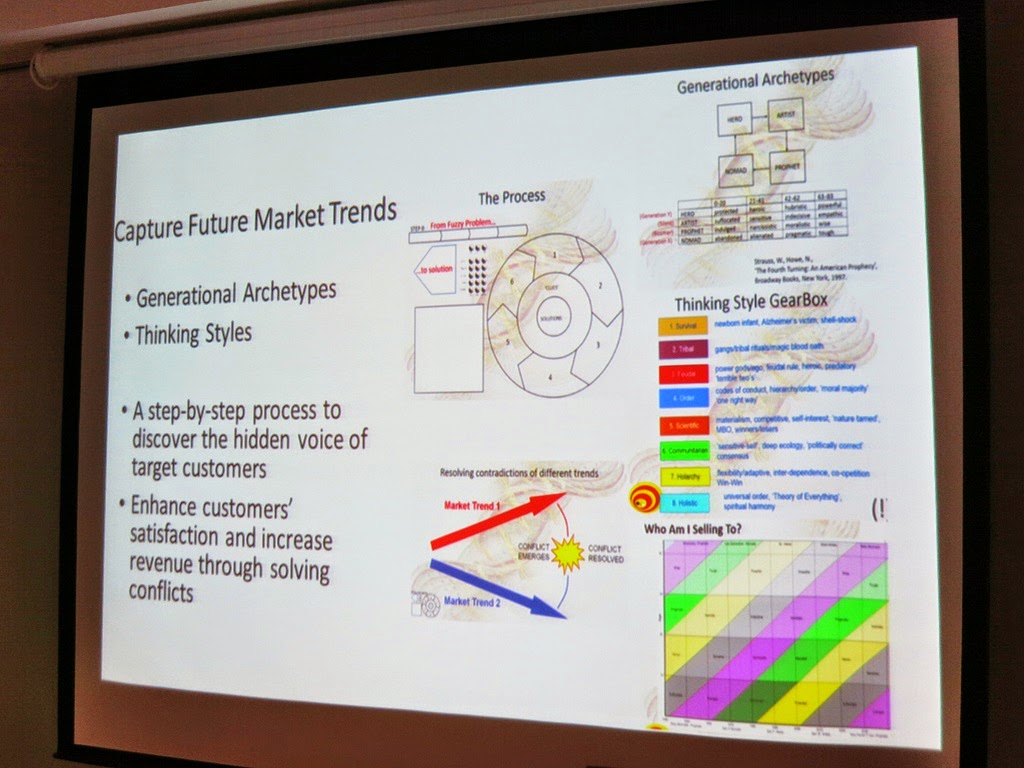(Left: Ms. Minda Chiang (Hon. Secretary), I (Former Chairman), Mr. Simon Tong (Coop member), Mr. Peter Fung (Chairman) and Mr. Vincent Cheng (Former Exco member))
Before the seminar, Mr. Peter Fung (Chairman, HKSQ) introduced some background of Hong Kong Society for Quality to our participants.
I was the first speaker and my topic entitled “Integration of Quality and Innovation Management System”. My content included introduction of ISO 9001:2015 (DIS) and CEN/TS 16555-1:2013 Innovation Management System. In the beginning, I defined a simple definition of Quality & Innovation Management System (QInnoMS) that is a set of elements of an organization’s management system for making better things better.
I briefed a new ISO 9001 standard which followed high level structure under a new ISO Directive Part 1:2012 “Annex SL”; and its some changes such as added risk and opportunity, as well as, enhance top management responsibility. Then I introduced the first standard on Innovation Management System (CEN/TS 16555-1:2013). I was the first person to introduce this standard in Hong Kong. This Technical Specification was approved by European Committee for Standardization (CEN)* on 21 April 2013 (issued in July 2013).
The model of Innovation Management System (InnoMS) employed PDCA cycle and idea tunnel. It also adopted the ISO Directive Part 1:2012 “Annex SL” structure included “Context of the Organization”, “Leadership for Innovation”, “Planning for Innovation Success”, “Innovation Enabling Factors”, “Innovation Management Process”, “Assessment”, “Improvement” and “Innovation Management Techniques”. Where the Innovation Funnel with different aspects included framing and insight generation, idea management, develop of the innovation project, protection & exploitation of outcome and market introduction.
The last part of my presentation was integrated ISO 9001:2015 (DIS) and CEN/TS 16555-1. It was found that many clauses were similar and could be integrated. The different clauses in CEN/TS 16555-1 from ISO 9001 were Innovation Management Process and Innovation Management Techniques.
Finally, I showed the overall model which combined ISO 9001:2015 model and CEN/TS 16555-1’s Innovation Funnel with Innovation Management Techniques. Then I demonstrated one of cases I employed in Technology Support Centre using TRIZ for sharing.
Mr. Peter Fung (Chairman, HKSQ) was the second speaker and his topic named “Design For Six Sigma (DFSS) Introduction”. First, he surveyed how many participants had experience on Six Sigma and DFSS. It observed little participants had experience in DFSS. He said that DFSS used to help you to deliver better products and services that your customers want and willing to pay for.
Then Peter used Pizza Express as example to explain what situation we employed Six Sigma or DFSS. He said Six Sigma used for improvement but DFSS used for new design of product or service (when improvement was not able to solve the problem). Then he briefed the steps of DFSS included Define (project), Measure, Analyze, Design & Verify (DMADV).
There were many tools which used in DMADV as follows:
D – VOC, QFD, Kano Model
M – Benchmarking, Capability Performance
A – TRIZ & Process Simulation
D – FMEA & DOE
V – SPC & Process Management
At the end he quoted Philip B Crosby’s Cost of Poor Quality Philosophy statement “Quality is free. It is not a gift, but it is free.” And he modified to “DFSS is free. It is not a gift, but it is free.” as Philosophy on Cost of Poor Design.
Mr. Simon Tong (Coop Member, Innovation Sub-Committee, HKSQ) was the last speaker and his topic presentation was “Innovation? Management? System? Yes Innovation Management System”. Firstly, Simon asked some questions “Can Innovation be systematic?” and “Does Management kill Innovation?” Then he used his teacher Mr. Darrell Mann’s answer “It Depends”.
Then he discussed management hierarchy from “Strategies, Business Models” to “System, Policy and Procedure”. (Simply, Philosophy to Methodology to Tools). He found that Innovation had philosophy and Tools (e.g. TRIZ, Design Thinking, UX, etc), but lack of systems to implement those tools. Then he proposed using the framework of Project Management Professional (PMP) to facilitate system approach innovation management.
After that Simon introduced Innovation Capability Maturity Model (ICMM) and there were five levels included “Seeding”, “Championing”, “Managing”, “Strategizing” and “Venturing”. It indicated from process innovation to societal innovation.
Simon questioned us “How to capture future market needs?” Then he introduced us another set of tools from TrendNA which could predict future market trends!
Reference:
HKSQ - www.hksq.org
HKSTP - http://www.hkstp.org/en-US/Homepage.aspx
*European Committee for Standardization (CEN) members are the national standards bodies of Austria, Belgium, Bulgaria, Croatia, Cyprus, Czech Republic, Denmark, Estonia, Finland, Former Yugoslav Republic of Macedonia, France, Germany, Greece, Hungary, Iceland, Ireland, Italy, Latvia, Lithuania, Luxembourg, Malta, Netherlands, Norway, Poland, Portugal, Romania, Slovakia, Slovenia, Spain, Sweden, Switzerland, Turkey and United Kingdom.
Related articles and seminar summary:
Innovation – From Art to Science - http://qualityalchemist.blogspot.com/2009/08/innovation-from-art-to-science.html
Innovation / Creativity Management (BS 7000-1:2008) - http://qualityalchemist.blogspot.com/2009/06/innovation-creativity-management-bs.html














沒有留言:
發佈留言